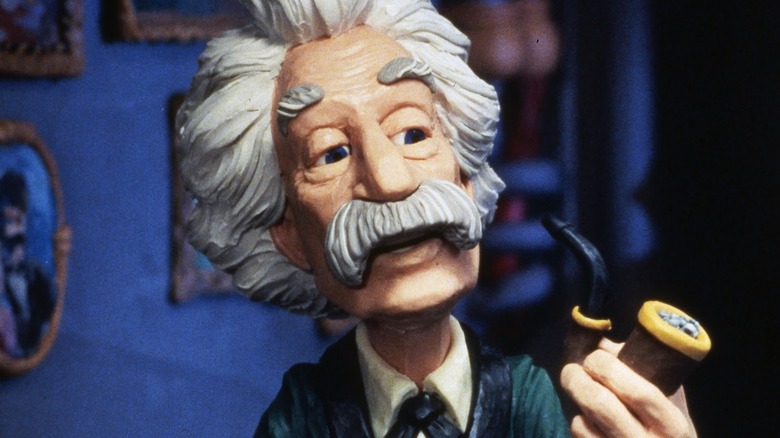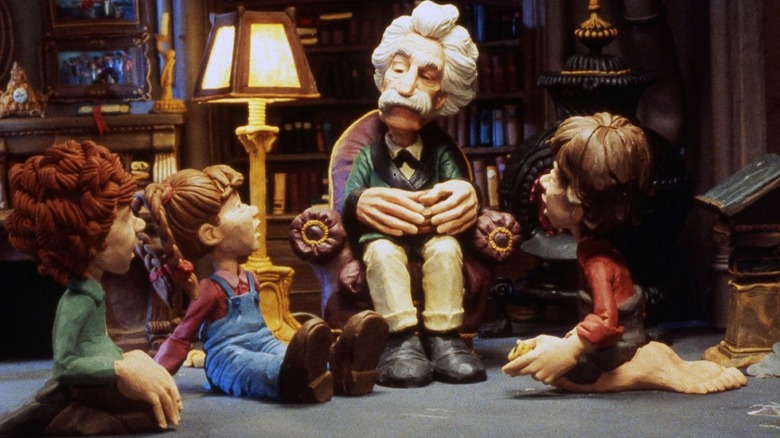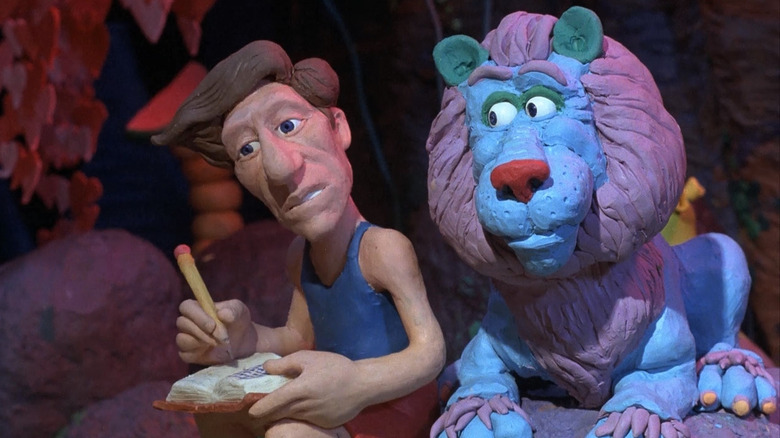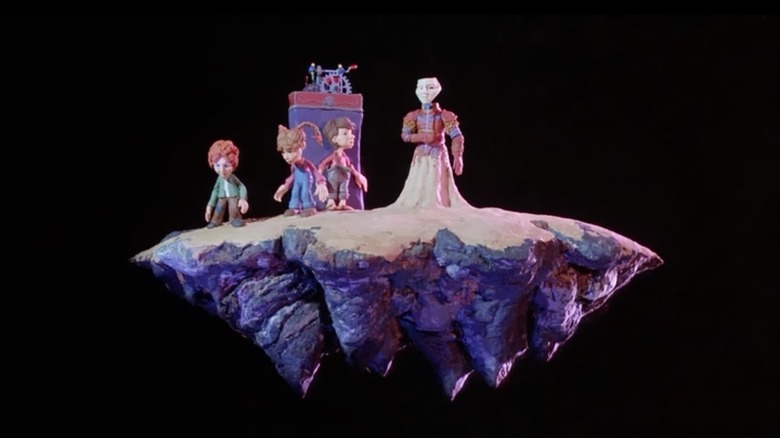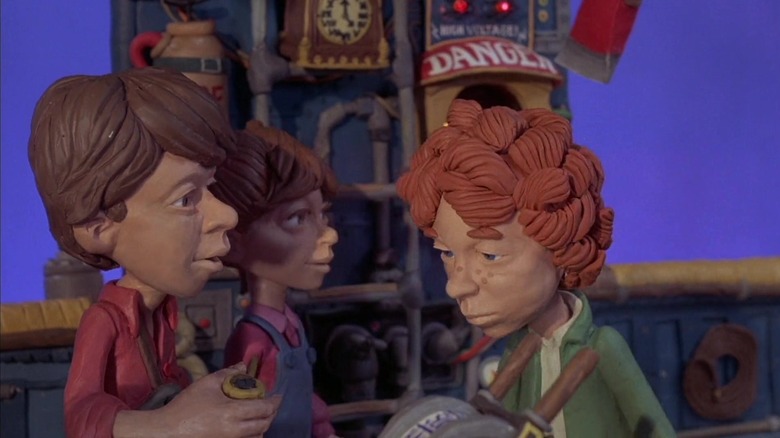The Daily Stream: The Adventures Of Mark Twain Offers Kids Nightmares And Literature
We may receive a commission on purchases made from links.
(Welcome to The Daily Stream, an ongoing series in which the /Film team shares what they've been watching, why it's worth checking out, and where you can stream it.)
The Movie: "The Adventures of Mark Twain"
Where You Can Stream It: Prime Video, The Roku Channel, Vudu, Tubi, Pluto TV.
The Pitch: Many young American children know the folksy and witty nostalgia literature by Samuel "Mark Twain" Clemens (1835 – 1910) merely by osmosis. Constant references made to his books, stories, and sayings in elementary school classrooms have left an indelible mark on generation after generation, and there's likely not a child over the age of nine who cannot recite back at least one story. Mark Twain, after all, wrote classics. An immediate addendum to that sentiment: Twain described a "classic" as something everyone wants to have read, but no one wants to read. And while there have been over 200 film adaptations of Twain's works, there is only one that captures the trifurcated nature of Twain's personality accurately — that is the folk hero, the sarcastic, and the man who dwells in darkness — and that is Will Vinton's 1985 animated feature "The Adventures of Mark Twain." Read on, gentle viewers, for a gorgeous and hilarious childhood nightmare come vividly to life.
Why it's essential viewing
Director Will Vinton was a pioneer in stop-motion animation who founded his own studio in the 1970s, and began breaking into the mainstream in 1977 with several animated fairy tale films like "Martin the Cobbler," "Rip Van Winkle," and "The Little Prince." Children of the 1980s might have seen the animated sequences that he did for "Moonlighting," or his work on the animated sitcom "the PJs." Vinton also designed commercials and ad campaigns, and he was the man responsible for The Noid, a creature that hated Domino's Pizzas. The Noid was popular enough to be featured in an NES video game. His animated ad campaign for California Raisins featured anthropomorphic raisins singing well-worn soul hits of the 1960s and 1970s, and it was so popular that the raisin characters were spun off into their own album, and their own TV special, which expanded into its own TV series. Vinton first made his way to my eye from the 1987 extravaganza "A Claymation Christmas Celebration." Vinton owns the copyright to the word "Claymation" and refers specifically to his work, even though popular usage has forced to word into describing any and all animation achieved with clay or plasticine.
Vinton worked in the realm of glorious caricature, creating characters with outside features and elongated heads. Faces and bodies would squash and warp. And while the animation was sharp and professional, it still possessed a few thumbprints and misshapen parts, lending it a glorious, wiggling life absent from modern examples of the form.
Vinton also worked on several feature films: deep-cut comedy fans will appreciate the title sequence he designed for the obscure 1992 comedy film "Brain Donors," and he was also the animator of the utterly terrifying children's film "Return to Oz," which featured a gigantic malevolent rock deity called The Gnome King. But Vinton only oversaw the production of one entirely Claymated feature film: "The Adventures of Mark Twain."
The film
"The Adventures of Mark Twain" hinges on an interesting piece of trivia about the author: He was born in 1835 when Halley's Comet was visible from Earth on one of its 75-year-long orbits. On its next orbit in 1910, Twain died. The premise of Vinton's movie is that Twain (James Whitmore) has built an elaborate, high-tech, space-faring zeppelin in order to drift into the heavens and meet Halley's Comet in person. The zeppelin is a steampunk dream, with multiple unseen floors and levels, accessed by a magical doorway that slides in and out of the floor. There is a library, of course, and a flight deck, but also unknowable featured like a room where Twain can play his pipe organ — a pipe organ which comes to life with singing, lamenting figures.
Stowing away on the zeppelin is none other than Tim Sawyer (Chris Ritchie), Huck Finn (Gary Krug), and Becky Thatcher (Michele Mariana), who will be Twain's audience as he tells stories and explains his mission. I do like the conceit that the author plays a role in the lives of his own creations. Twain wrote them, and now they require additional shepherding in order to persist and grow as characters. Apart from W. Somerset Maugham in 1946's "The Razor's Edge" and Charles Dickens in 1992's "The Muppet Christmas Carol," I can't think of movies wherein real-life authors interact with their own fictional creations. Tom, Huck, and Becky will gather around to witness animated versions of "Extracts from Adam's Diary," "Eve's Diary," "The Celebrated Jumping Frog of Calaveras County," and "Captain Stormfield's Visit to Heaven." The latter of those stories features a gaggle of three-headed space aliens whose heaven involves a sex-soaked disco. "The Adventures of Mark Twain" may be the only Twain-inspired film to feature a sex-soaked alien disco afterlife.
Also notable: There is a fourth stowaway on board the zeppelin, who is dressed in black, and whose face we never see. It doesn't take too much intuition to realize that this is the "dark" version of Mark Twain. The man in the white suit was the quippy, folksy society gentleman. The man in the black suit was the Twain who wrote about death and despair, which were notably common themes in many of Twain's short stories. Vinton's film doesn't just teach kids about Twain's stories, but provides a critical analysis of his work, arguing that there are two Mark Twains inside of Samuel Clemens, battling for dominance.
The Mysterious Stranger
The zeppelin's magical door can also physically transport the characters into Twain stories which also exist as floors on the fantastical craft. Tom, Huck, and Becky are a little flustered by the technology and find themselves stepping into "The Mysterious Stranger," a fragmented novel that Twain never completed (there are differently assembled versions of the story made after Twain's death). The story is about a handsome teenage boy named Satan who visits a small Austrian village in the late 16th century and proceeds to predict the death and downfall of three children he has befriended. Satan takes the children on a tour of the world where they witness horror after horror, witch burnings and murders and death. The story ends with Satan explaining that "there is no God, no universe, no human race, no earthly life, no heaven, no hell. It is all a dream. A grotesque and foolish dream. Nothing exists but you. And you are but a thought — a vagrant thought, a useless thought, a homeless thought, wandering forlorn among the empty eternities!"
In "The Adventures of Mark Twain," Tom, Huck, and Becky stumble out onto a floating island in the middle of a vast black void, and are greeted by a headless soldier, Satan, holding a mask where its face would be. It is able to build a sandcastle, and the children are encouraged to add people to the diorama. Satan then gives the children's sculptures life. When the sculptures begin bickering and fighting, Satan gets annoyed and murders them all. The sculptures wail in agony before dying and sliding back into apertures in the ground. "People are of no value," Satan says. "We could make more sometime. If we need them." Satan's face becomes a death head, and the children flee in abject fear. "Life itself is only a vision," Satan continues alone. "A dream. Nothing exists, save empty space and you. And you are but a thought."
This is an anvil of nihilism to drop on an audience of children, and can even leave adults feeling hollowed out. Twain was not the warm, fireside grandfather of legend, but a complex author with dark thoughts and a tendency toward sadness. Will Vinton's "Mysterious Stanger" captures Twain's hopelessness in an intense nightmare sequence that no child will walk away from unmarked. Lovers of dark literature will often buzz around Edgar Allan Poe or Shirley Jackson or Franz Kafka or Charles Baudelaire, but they would do well to check out some Mark Twain.
Joy and melancholy
There is a tendency to think of children's entertainment as being gentle, safe, unthreatening, and innocuous. I would argue that children are sophisticated people who can handle a sophisticated gamut of emotions in their movies. As such, you'll find children who like sad stories, weird stories, and even scary stories. I think kids like to be scared, to test their limits a little bit.
"The Adventures of Mark Twain" is a film to test those limits. To scare, giggle, be baffled, and be warmed by the film's bittersweet ending; keep in mind that it takes place in 1910 when Mark Twain died. The film ends with a teary farewell, but also of one of the characters wearing a pair of novelty Groucho glasses.
Will Vinton would direct multiple short films after 1985, and make the above-mentioned ad campaigns, but wouldn't make another feature film as a director. In 2006, Vinton was one of the producers of the CGI animated Disney flick "The Wild," a knockoff of "Madagascar." Will Vinton's studios eventually transformed into Laika, the stop-motion animation studio behind "Coraline," "ParaNorman," and "The Boxtrolls." Vinton passed away in 2018. The 2021 film "Claydream" details Vinton's life and work, and it debuted at Tribeca. Keep an eye out for that film when it finally gets released. '
In the meantime, stream "The Adventures of Mark Twain."
